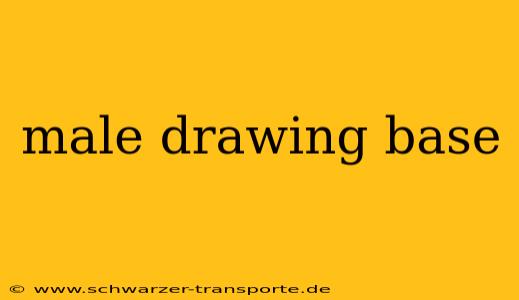Meta Description: Unlock the secrets to drawing realistic and dynamic male figures! This comprehensive guide provides a deep dive into male anatomy, offering drawing bases, tips, and resources to elevate your art. Master proportions, musculature, and poses with our expert advice and downloadable resources. Learn how to draw convincing male characters, from superheroes to everyday people.
Understanding the Male Figure: Proportions and Structure
Drawing believable male figures starts with understanding their underlying structure. While individual variations exist, understanding standard proportions is crucial. A common approach uses the head as a unit of measurement. The average male figure is roughly 7-8 heads tall.
Key Proportional Landmarks:
- Head: The foundation of your measurement system.
- Shoulders: Typically twice the width of the head.
- Chest: Broad and deep, tapering towards the waist.
- Waist: Narrower than the chest and shoulders.
- Hips: Relatively narrow compared to the shoulders in most males.
- Legs: Approximately equal in length to the torso (head to hips).
Using Drawing Bases: A Foundation for Success
Male drawing bases provide a simplified skeletal structure, offering a framework upon which to build more detailed anatomy. These bases are invaluable for practicing poses and understanding the relationship between different body parts. Many artists create their own, focusing on key joints and lines of action.
Finding Free Male Drawing Bases: Numerous websites and online communities offer free downloadable drawing bases. Search for terms like "male anatomy base," "male figure template," or "male body base." Be sure to review the license before using any resource.
Delving Deeper: Musculature and Form
Once you have a grasp of basic proportions, it's time to add musculature. The male form is characterized by more prominent muscle definition than the female form, although this varies significantly based on body type and physique.
Key Muscle Groups to Study:
- Chest (Pectorals): Fan-shaped muscles covering the chest.
- Shoulders (Deltoids): Three heads that create the rounded shape of the shoulder.
- Back (Latissimus Dorsi, Trapezius): Large muscles responsible for the width and strength of the back.
- Abdominals (Rectus Abdominis, Obliques): Define the abdominal region.
- Legs (Quadriceps, Hamstrings, Calves): Powerful muscles that make up the legs.
Observing Real-Life References:
Don't underestimate the power of observation! Study real-life references—photos, sculptures, even mirrors—to understand how muscles interact and change shape during different poses and movements.
Mastering Poses and Dynamics
Understanding anatomy is only half the battle. Learning to draw dynamic poses adds life and energy to your artwork.
Tips for Drawing Dynamic Poses:
- Line of Action: Establish a central line of action that dictates the overall movement and flow of the pose.
- Gesture Drawing: Focus on capturing the essence of the pose quickly, emphasizing movement and flow before adding details.
- Perspective and Foreshortening: Understand how perspective affects the appearance of the body when viewed from different angles.
Resources for Further Learning
Several resources can help you improve your male figure drawing skills.
Recommended Books:
- Force: Dynamic Life Drawing for Animators by Mike Mattesi
- Figure Drawing: For All It's Worth by Andrew Loomis
Online Tutorials and Courses:
- Proko: Offers excellent anatomy courses.
- Schoolism: Provides high-quality art education.
Conclusion: Practice Makes Perfect
Mastering male figure drawing takes time, dedication, and consistent practice. By combining a solid understanding of anatomy with regular practice using drawing bases and real-life references, you'll significantly improve your abilities and create more convincing and dynamic male characters in your artwork. Remember to utilize the resources available and keep pushing your artistic boundaries! Happy drawing!
